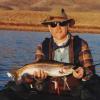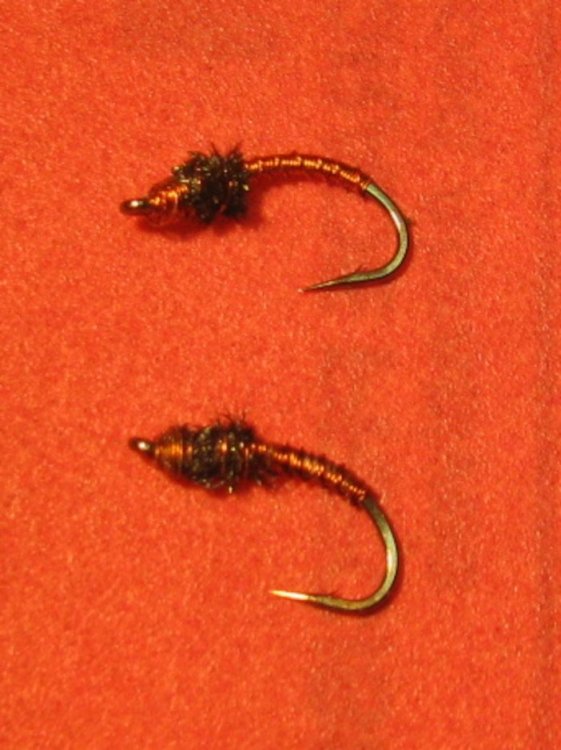-
Content Count
3,567 -
Joined
-
Last visited
Posts posted by utyer
-
-
In more than 55 years, I have used a lot of different vises. In all of them, I first looked for the hook holding capability of any vise. Secondly, I looked for the size range of hooks that any vise would give me. I first started looking for rotary features after about 10 or 12 years. I tried several different rotary vises, and in 1991 or thereabouts, I saw a "Nor-vise" at a trade show. Norm Norlander was the designer, and was there showing what his vise did. I bought the one he was using that day. I didn't want to wait for him to send one. At the end of the day picked it up, and have never looked for another vise. I sold or gave away all my other vises. 34 years later, it is still my only vise. It does every thing I need, and is still going strong. The Longevity of a good vise is also something that one should look for.
-
Some sort of finish knot is almost always needed. You can learn to make a Whip finish from many sites on Utube. You can also finish off with a half hitch and a tiny drop of super glue.
Just for clarification: I I have been using Gutermann Skala threads for well over 25 years. I used to get mine from Oshman, Brothers but now use Wawak. The cost for these spools is expensive, but when you breakdown the cost with the yards, you will find that a 100 yard spool is less than 25 cents. One other thread that is use for salt water patterns, or other LARGE flies is Gutermann Bulky Nylon, which I get at Joann Fabrics. As I said, I use only white thread and color heads with a marker when necessary.
-
I have tied since 1966, all that time with 20/20 vision in just one eye. I lost the vision in the right eye in 58 or 90. After surgery to reattach the retina, I only had some peripheral vision in the right eye. I had to start wearing glasses somewhere in the early 90s. I do use magnifiers on anything smaller than a size 18. Saltwater patterns are no problem. At 79, I feel lucky to be able to tie any flies I need. I can still tie size 22 or 24 midges. I use a 20" LED overhead light bar. I have at least 5000 patterns stocked away so when the time comes, I can still keep on fishing without tying for a good while. Knock wood.
-
I have had my Nor-Vise since 1991. Still does everything I need a vise for. I have had many other vises, but I won't trade my Nor-Vise for anything ever.
-
I simply make mine from packing foam. Easy to make and free.
-
-
That is one crazy pattern. Very well done.
-
The chart is a good one, but the only thing I use it to look for different useful hook configurations. Then I find more cost effective similar hooks. Cant justify the expense.
-
Spent about 40 years living and fishing in Utah, Idaho, & Wyoming. Lots of good fly fishing for trout, bass, and bluegill. I still go back at least once every year. I can help you with where, and when, as well as what flies to uses and fly tying. These questions should be done in PMs.
-
Welcome, we have fished a LOT of the same places through the years. I have more than 12 years on you as far as tying goes. We have done a lot of the same things as well.
-
-
I too tie on a Nor-vise. I have had mine since 1991, and wont part with it. I have had many other vises, but once I got my Nor-vise, I never looked back. I have the fine point, standard, and Saltwater jaws. All the jaws rotate inline.
-
Trying to squeeze the lever on a Regal vice was the first signal of the start of arthritis in my right hand. I got the reel back from a friend that I had given it to many years ago. I gave it to my niece for her new husband. Voltaren works ok on the arthritis, not sure about carpel tunnel.
-
The best advise I can give you is to TRY BEFORE You BUY any Kayak. I tried 14 different kayaks before buying mine. Tipped the first one over on my first outing on a cold February day, and vowed not to have that happen again. So far, it hasn't happened again. The seat is a standard folding boat seat, with a swivel plate, so I can turn the seat to get to gear stored behind me. I raised the seat using about 3" higher with aluminum rails. Its quite easy on my legs and back.
I gave away my inflatable pontoon before moving to Florida. There is no way I fishing with my feet in the water down here. I have seen way too many gators while fishing. I fish in several rivers, lakes, and the in-shore lagoons near Cape Canaveral, but I don't use mine in the surf. After reading the replies below you can see why.
The NuCanoe is about $1600.00, and I just looked at the "new" seat platform. It places their seat at about the same level as the one I built. The weight is about 70 to 75 pounds, and I can load it on my Subaru Forester. But with your back issues, a trailer would be a better option. Again, find a local dealer, and TEST it before buying. The next best Kayak that I test drove was a Hobie but it was almost 3 times the price.
-
There are Kayaks "called sit on top<" that work well for fishing in general. Personally, I use a "NewCanoe." They are wider, and much more stable. I never worry about standing when using mine. I built a higher seat platform for mine that has good back support. You can of course fall out, but you cannot tip over. You fall out, and the kayak doesn't roll, it just flips back to upright position as you fall out. IT tip mine one would have to hold on to the sides to pull the kayak over. Its very difficult to roll other wise. It has a squared off back end which allows you to install a small (2.5) motor, or any of a number of electric motors.
-
The Shower rods are a good start. but your rods will be sliding left and right as you make turns. Some longer fly rods will have to be in pieces. Try using a pool noodle, cut into sections and sliced in the middle to keep the rods from moving.. I would suggest several noodles on the front rod. Then place noodles between the shower rings in back. Use a slit in the center of each front noodle section to keep rods from sliding forward or back, The hole in the noodle will be a tight fit over the Shower rod. Just my thoughts.
On the roads I travel to fish, my rods are always in the tube until I set it up when I am done traveling.
-
I started tying on my father's Thompson A in 1955. Trying to duplicate patterns I saw in a Herters Catalog. After we moved to Utah in 57, the vise was packed away, and "lost for about 6 years. Then in 66, I found it again and Used it for years. In 71 I got a Thompson Pro with 2 extra jaws. This one lasted me until I passed it and the Thompson A model down to my Niece and Nephew. They still work just fine, going strong after more than 65 years. The "new Thompson products are maid in Asia somewhere and I don't think they will match up to the "real D H Thompsons."
I tried lots of other vises in the 70s, and 80s. Then in 91, I got a Nor-Vise. It is still going after more than 20 years and 10,000 flies.
-
I would second the Okuma reel. Quite inexpensive, and mine have worked fine.
-
I built a board, and did a few dozen furled leaders about 20 years ago. For many years I built my own leaders using a formula for each section I found in a Fly Fisherman Magazine. Then I did build a board about 20 years ago and made some furled leaders. Never thought they were worth the effort. So I went back to tying sectional leaders. I still use the same formula. There are 2 parts:, first the butt section is simply the full leader length you want to tie divided by .275. (Butt section = L x .275) each other section uses this formula (Ln=Lp*.55*(dp^/dn^) I did the math, and built a chart now I simply follow the chart. I use standard mono-filament, and each leader works out to cost less that 50 cents. If your interested, in trying this method, PM me and I will send you my charts.
-
I spent over 40 years fishing in UTAH, and get back there every year. I will be back in July this year, to fish several of my favorite "secret spots," and of course the Green.
-
-
I re-work hooks all the time. None for blind eye, but adjusting the shank and bend. I use several longer shank hooks that come with offset bends, and straiten them out and the change the shank bend.
-
I have 3 sets of waders. My Simms are over 15 years old, the first day I had them on, I snagged them on a thorn. Used the included UV patch kit, while in the stream, they have not leaked since. I have a waist high pair from Cabelas, that are also about 15 years old. Never had a leak, These are now stored in Utah for my western fishing. I bought a cheap pair for use in Florida, that only get used for walk in Shad fishing. Three or 4 years old, and have had no problems yet.
From my experience, I don't agree with the video's conclusions. What I do think are "rip offs" are thousand dollar fly rods. If I can cast far enough with a two hundred dollar fly rod, I know I won't cast 5 times as far with a rod selling for 5 times more.
-
I did meet Mr Whitlock, in about 1980 when he did a demonstration in our shop. Small shop, and the group attending filled our tying area most of the day. Very personable man, and a great fly tier. His patterns were inventive, and very down to earth. Sad to hear about his passing.








Lots of money up in smoke
in The Lodge
Posted · Report reply
I quit in 1964, (I was 20,) never missed it. Tried for a long time to get my brother to stop, but it took him about 40 years longer. I worry more about him than anyone else.